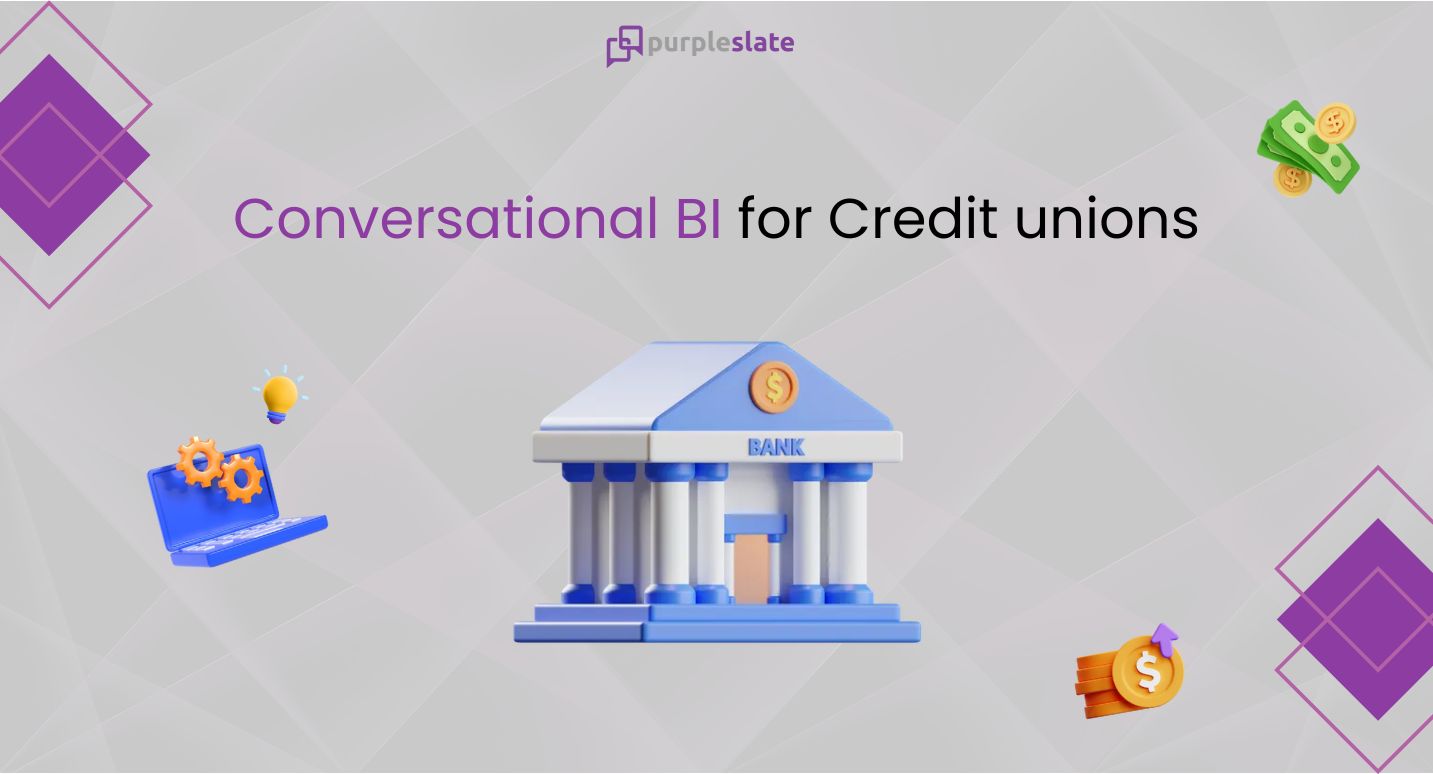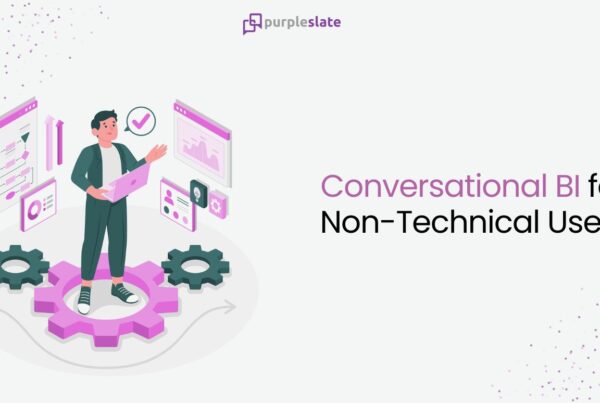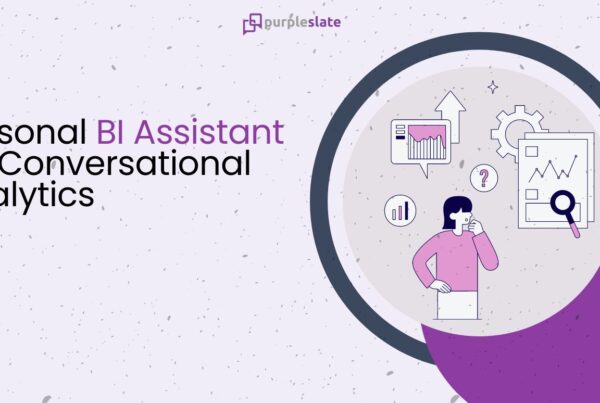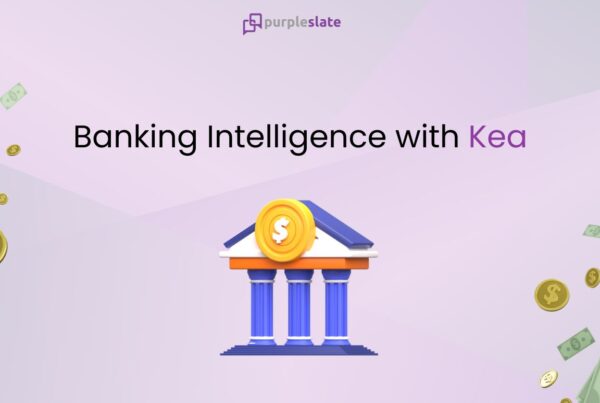
Introduction
Debt ratios, lender credibility, borrower credibility, credit score, institutional borrowing, these are some of the words everyone who would have interacted with any finance professional would have heard. From the tallest building in Wall Street to the community lender around the corner, banks and credit unions work right on the intersection of economics and money management. But money is a moody beast. A lot of factors influence its behavior. And be it anyone in financial services, they need to have access to the right insights at the right time to ensure their bet pays off.
Suffice to say time must be on the finance professionals’ corner and it’s a mission-critical resource. Here’s where an emerging concept in the world of business intelligence can come to the rescue of the finance professionals. A simple concept called conversational business intelligence, where all a finance leader like you must do is Talk to Your Data™.
What is Conversational Business Intelligence?
Conversational Business Intelligence (BI) is the principle of using natural language to derive actionable insights from your data. To help you visualize it, think of a Siri like interface where you can ask your data – “Hey Kea, what’s the credit rating for Acme Corp?” or “How many loans have John Doe defaulted on in the past 10 years?”.
Conversational BI has emerged as a game-changer, offering real-time, interactive analytics that empower banks and credit unions to make informed decisions quickly and effectively. In this blog, we’ll delve into the transformative potential of Conversational BI, focusing on Kea as a leading platform tailored for the unique needs of the financial sector.
Conversational BI represents a significant shift from traditional BI methodologies, which often rely on static reports and predefined dashboards. With Conversational BI, users can engage with data using natural language queries, allowing for more intuitive and interactive data exploration. This approach enables users to ask questions in plain language and receive instant responses, eliminating the need for complex SQL queries or predefined reports.
The real-time nature of Conversational BI is particularly valuable in the fast-paced environment of financial services, where decisions must be made quickly and accurately to capitalize on market opportunities and mitigate risks. By providing instant access to up-to-date insights, Conversational BI empowers financial institutions to stay agile and responsive in an ever-changing market landscape.
The Challenges of Traditional BI in Banking and Credit Unions
Financial institutions, including banks and credit unions, encounter unique challenges when utilizing traditional BI tools. Here’s how these challenges manifest in the banking and credit union sector.
Data Silos
Traditional BI tools often struggle to integrate data from disparate sources, resulting in data silos where information is isolated within separate systems or departments. This fragmentation inhibits collaboration and prevents users from accessing a unified view of the business.
In a bank, customer data may be stored in separate systems for retail banking, mortgage lending, and wealth management. Without integration, employees struggle to gain a comprehensive view of customer relationships, hindering cross-selling opportunities.
Complex User Interfaces
The user interfaces of traditional BI tools are frequently complex and cumbersome, requiring extensive training and expertise to navigate effectively. This steep learning curve poses a barrier to adoption, particularly for users outside of the IT department or data analytics team.
For example, a credit union’s compliance team uses a legacy BI system with a cluttered user interface and convoluted reporting processes. Compliance officers find it challenging to generate regulatory reports accurately and efficiently, increasing the risk of compliance breaches.
Limited Interactivity
Traditional BI tools typically offer limited interactivity, confining users to predefined reports and dashboards. This lack of flexibility stifles exploration and discovery, hindering users’ ability to derive actionable insights from their data.
For example, a credit union’s marketing team analyzes member transaction data to identify opportunities for targeted promotions. However, the BI tool they use provides pre-defined reports with limited interactivity, making it difficult for marketers to explore data trends or segment members effectively
Lack of Real-Time Insights
Many traditional BI tools are unable to provide real-time insights, relying instead on static reports generated at regular intervals. This delay in accessing data hampers decision-making processes, especially in fast-paced environments where timely insights are crucial.
Bank branch managers rely on daily or weekly reports to track branch performance metrics, such as customer foot traffic and account openings. However, these reports provide historical data and do not reflect real-time changes in branch activity, hindering managers’ ability to respond promptly to operational challenges or market trends.
High Maintenance Costs
Maintaining and updating traditional BI systems can be costly and time-consuming, requiring dedicated IT resources and ongoing investment in infrastructure. This cost burden can deter organizations from fully leveraging their BI capabilities.
Mid-sized credit unions operate multiple branches across different geographic regions, each with its own BI system. The credit union incurs high maintenance costs to support these disparate systems, including licensing fees, IT staff salaries, and infrastructure expenses, diverting funds from member-centric initiatives or community outreach programs.
Scalability Challenges
Traditional BI systems may struggle to scale effectively to accommodate growing data volumes and user demands. As organizations expand and generate more data, scalability becomes a critical concern that traditional BI tools may struggle to address.
Rapid growth in member base can be experienced by any credit unions based on their service offerings. This may even compel them to release new financial products. Traditional BI systems may not be equipped enough to handle the sudden surge in data.
Addressing these challenges requires a modern approach to BI that prioritizes agility, flexibility, and ease of use. Conversational BI platforms like Kea offer a compelling solution by providing real-time insights, intuitive interfaces, and a single point to collaborate, empowering banks to overcome the limitations of traditional BI tools.
Introducing Kea for Banking and Credit Unions
Kea represents a paradigm shift in BI, offering a Conversational BI platform specifically designed to meet the needs of banks and credit unions. At its core, Kea is designed to make data analysis more accessible and intuitive for users across the organization. By providing a conversational interface, Kea allows users to interact with data using natural language queries, enabling them to ask questions and receive instant responses in plain language.
In addition to its intuitive interface, Kea offers real-time insights that enable users to access up-to-date information whenever they need it. This real-time functionality is particularly valuable in the fast-paced world of financial services, where market conditions can change rapidly, and decisions must be made quickly to capitalize on opportunities or mitigate risks.
Key Benefits of Implementing Kea in Banks and Credit Unions
A Conversational BI platform like Kea brings a myriad of benefits to banks and credit unions, including faster decision-making, improved collaboration, and enhanced user experience. Kea addresses the shortcomings of traditional BI tools by providing instant access to insights and fostering a culture of data-driven decision-making.
- Cost Savings: By offering a cloud-based, scalable solution, Kea reduces the need for costly infrastructure investments and IT support. Through streamlined data management processes and improved operational efficiency, Kea helps banks and credit unions optimize resource allocation and reduce overall costs. This cost-effective approach enables institutions to maximize their return on investment while maintaining a competitive edge in the industry.
- Enhanced Decision-Making: Kea provides decision-makers with instant access to actionable insights, enabling them to make informed decisions quickly and confidently. By democratizing data access and promoting collaboration across all levels of the organization, Kea facilitates data-driven decision-making processes. Whether it’s frontline staff responding to customer inquiries or senior management strategizing for the future, Kea empowers institutions to leverage data effectively in their decision-making processes.
- Improved Customer Service: Kea revolutionizes customer service in banks and credit unions by providing instant access to real-time customer data. With this capability, frontline staff can offer personalized service and address customer inquiries promptly. By anticipating customer needs and tailoring solutions based on insights derived from Kea, institutions can significantly enhance overall customer satisfaction levels.
- Enhanced Risk Management: One of the critical advantages of Kea is its ability to empower banks and credit unions with real-time analytics on market trends, customer behavior, and transaction data. This enables institutions to identify and mitigate risks more effectively across various domains, including credit, market, and operational risk. By leveraging insights from Kea, institutions can proactively manage risk and safeguard their financial stability.
- Increased Operational Efficiency: With its user-friendly interface and intuitive query capabilities, Kea streamlines data analysis processes in banks and credit unions. By empowering staff with self-service analytics capabilities, Kea reduces the time and effort required to extract insights from data. This not only enhances operational efficiency but also frees up IT resources, allowing institutions to focus on strategic initiatives and innovation.
- Facilitates Product Innovation: Kea empowers banks and credit unions to gain deeper insights into customer preferences and behavior. By analyzing customer feedback, transactional data, and market trends, Kea supports data-driven product development initiatives. This enables institutions to identify market opportunities and develop innovative products and services that meet evolving customer needs effectively, thereby enhancing their competitive position in the market.
Closing Notes
In banking and credit unions, traditional BI tools often grapple with challenges that affect decision making, often hitting them where it hurts most – profitability. However, with Kea, these challenges are swiftly overcome. Kea’s intuitive interface, real-time insights, and collaborative capabilities revolutionize data analysis, empowering banks and credit unions to stay agile and responsive amidst the fast-paced financial landscape.
As finance professionals embrace the era of Conversational BI, they unlock a plethora of benefits with Kea paving the way for a brighter future in finance. By implementing Kea, banks and credit unions can embark on a transformative journey towards data-driven excellence and leveraging insights to fuel innovation.




